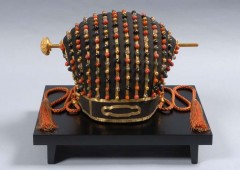2013.11.18
Inca Empire subject of new Okinawa exhibition
The Okinawa Prefecture Museum & Art Museum has done it again, bringing a world class exhibition – The Inca Empire Revealed: A Century After the Manchu Picchu Discovery — for a nearly three-month run.

A mummy of an adult man who was buried with huge earrings leading researchers to believe he had been a member of aristocracy.
The exhibition, celebrating the 100th year of the discovery of Peru’s lost city, Machu Picchu, is running through Feb. 2nd. The exhibition runs daily, except closed on Mondays, at the Okinawa Prefectural Museum & Art Museum, 9 a.m. ~ 6 p.m., with extended hours to 8 p.m. on Fridays and Saturdays. Admission to the exhibition costs ¥1,200 for adults, ¥800 for university and high school students, and for junior and elementary school students 600 yen.
Machu Picchu is located in Cusco, Peru. It was built around 1450, at the height of the Inca Empire, and was abandoned just 100 years later as a belated result of the Spanish Conquest. Protestant missionary, Hiram Bingham III discovered Machu Picchu in 1911 with the guidance of local indigenous farmers, and made its existence public.
Since then many theories and mysteries have arisen of the lost empire, and investigations are still conducted today. Machu Picchu was declared a Peruvian Historical Sanctuary in 1981 and a UNESCO World Heritage Site in 1983. In 2007, Machu Picchu was voted as one the New Seven Wonders of the World in a worldwide Internet poll.

This “khipu” is from the 15~16th century. The knots on the ropes record information on history, religion and statistics using decimal principles.
In this exhibition, visitors may understand why thousands of people are drawn to this fascinating and mysterious site, while learning of new discoveries of the Inca civilization. Visitors will also be able to experience a tour of Machu Picchu through a 3D sky view theater.


 2024.07.07
2024.07.07 2024.07.02
2024.07.02 2024.06.11
2024.06.11 2024.06.03
2024.06.03 2024.05.02
2024.05.02 2024.04.26
2024.04.26 2024.04.04
2024.04.04 2024.04.02
2024.04.02 2024.03.03
2024.03.03 2024.02.26
2024.02.26






